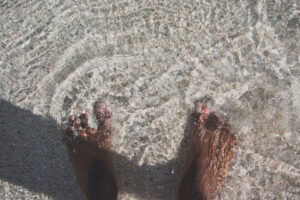Bunions: The Uninvited and Painful Guests on Your Feet
Your feet could be your most reliable form of transportation or your favorite body part to express your fashion tastes. However, sometimes, they betray you. They may scream in pain, or their shape might begin to resemble a child’s drawing. This may be a sign bunions are in your future. Discover bunion symptoms, how to identify them, and ways to prevent and treat them.
What Are Bunions and Their Causes?
Bunions are a common and treatable concern. They cause bumps on the sides of your foot beside the big toe. They less frequently show up near the pinkie toe, affectionately called bunionettes because of their smaller size.
Extended, long-term pressure on the joint connecting the big toe to the foot is what causes bunions to develop over time. They form because bone and tissues enlarge and shift. The area can also fill with fluid as the toes misalign and potentially overlap one another. This explains some of the causes of bunions, which include:
- Wearing high heels or tight, pointed, or small shoes
- Arthritis
- Genetics and family history
- Injuries
- Pregnancy
- Other lifestyle factors like standing a lot at work
- Aging
- Prior treatment.
Recent research shows which risk factors are more likely to lead to complications during treatment, and it includes people who have undergone surgeries before.
Don’t be surprised if your foot starts developing a funny shape or redness. These are telltale bunions symptoms that are easy to see and feel. Your foot will be tender, stiff, or numb, and walking might be more challenging. Calluses and hammertoes are also red flags.
How Can You Prevent Bunions?
Around 3 million bunions torment U.S. toes annually. Thankfully, they are manageable and preventable.
One of the most important techniques is choosing the right footwear. The best shoes for bunions are wide and padded. Women are at greater risk because they often wear too-small shoes or pressure-inducing high heels.
If your feet tend to roll inward, you may unintentionally invite bunions. Do corrective stretches and exercises to adjust foot mechanics and walk straighter.
Paying attention to holistic health is another way to stop funky foot formations. This includes a healthy diet and exercise alongside regular wellness visits. You’ll also want to collect information from your family members to identify possible genetic predispositions.
How Do You Treat Bunions?

These are the most consistent and reliable bunion treatment options and advice you can get.
Signs That You Might Need Bunion Surgery
Everyone should know when to see a doctor for bunion pain. It might be more than home remedies can handle if it grows too large or becomes unbearably painful. Your shoes might also no longer fit. Other ailments like osteoarthritis or bursitis are complications arising from untreated bumps.
Doctors will issue an X-ray to get a better look at the situation before making a determination. They could recommend a procedure like lapiplasty, which fixes the anatomy causing the problem and puts everything back into place.
How to Treat Bunions Without Surgery
Always ask your primary care doctor or a podiatrist for their professional advice to see if you can avoid seeing an orthopedic surgeon. You might notice it early enough that icing and medication suffice.
There are also plenty of effective exercises for bunion pain relief, which is why physical therapy is another treatment. They include:
- Toe circles
- Toe abductions
- Heel raises
- Extensions
- Curl and points
- Toe spread-outs
- Towel scrunches
Doctors might recommend an over-the-counter solution or prescribe another medication, like an anti-inflammatory or pain reliever. You can also try shoe inserts or pads, and tape is another popular choice. All these are available at most drugstores.
Can bunions be reversed with lifestyle changes? There are plenty of accessible and natural remedies for bunion pain and inflammation. Rotate between icing and doing warm soaks, wear roomy shoes, and exercise regularly.
However, you must know bunions don’t just go away on their own. You’ll need to take some action, or they could worsen.
Putting Your Best Foot Forward
A pesky toe bump won’t resign you to the couch forever. You’ll be up and running in no time if you have one, but only if you take the right precautions and see a doctor. You can also prevent them by wearing cozy, supportive shoes and learning about your genetics to ensure you’re not at risk. Then, you’ll be ready to step out in style.
Please follow and like us: